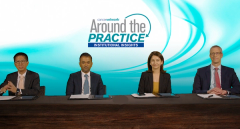
Bispecific Antibodies in the Treatment of RRMM
Comprehensive perspectives on the role of bispecific antibodies in the treatment of relapsed/refractory multiple myeloma.
Episodes in this series

Transcript:
Noopur Raje, MD: We are very excited about these bispecific T-cell engagers, which are off the shelf. Andrew, you mentioned one that is targeting BCMA [B-cell maturation antigen]. We have several BCMA bispecific T-cell engagers in clinical trials, and our hope is that if not by the end of this year then at least early next year, we should have a couple of bispecific T-cell engagers approved. We saw some nice data presented at this year’s ASH [American Society of Hematology Annual Meeting & Exposition]. We saw the MajesTEC [trials] data with teclistamab, which is a bispecific T-cell engager against BCMA. Can you give us a sense of those data, a broad overview?
Andrew J. Yee, MD: There are multiple bispecific antibodies targeting BCMA, and teclistamab is probably the furthest along the clinical development….At this time it’s too early to know if one is better than the other, but teclistamab is furthest ahead in terms of number of patients who are enrolled in the phase 2 dose. The recent data that were presented at ASH showed that teclistamab, [which was given to approximately] 150 patients at the recommended phase 2 dose. It showed a great response; the overall response rate was around 60%. This is a triplet-class refractory or exposed patient population, and one of the first times you see PFS [progression-free survival] data presented, so the 9 months PFS was [approximately] 60%. When I think about these results—this is again for bispecific antibody, it’s different because at the end of the day, we have more choices, we have different ways of targeting. BCMA can do the CAR T [chimeric antigen receptor T cell], the cellular therapy-based approach with ide-cel [idecabtagene vicleucel] and cilta-cel [ciltacabtagene autoleucel], and then we have the antibody drug conjugate belantamab mafodotin [Blenrep]; compared with belantamab mafodotin, the PFS was about 2.9 months and the overall response was 30%. When you bring the power of the immune system, you can generate higher responses. The caveat…is that there is risk of cytokine release syndrome and there is risk of neurotoxicity. In teclistamab data, the cytokine release syndrome CRS was about 70% and tocilizumab usage was about 30%. That’s something to think about. We are early in how we are using these new therapies. Another point is that this is targeting BCMA. B-cell maturation is important, as you need B cells to make antibodies…..As we are developing these bispecific antibodies, hypogammaglobulinemia infections [will be] something to think about when we are using these drugs in the future.
Noopur Raje, MD: You are right. As we target BCMA, it is going to impact the incidence of infections, but that’s something, and we will talk about CRS and neurotoxicity in a little bit. Andrew, as you pointed out, besides teclistamab, there are other bispecifics that are in clinical development as we speak, and a lot of that data was presented at this year’s ASH. But it’s not just BCMA, we are also targeting other interesting proteins on the myeloma cell surface, and there were data presented at this year’s ASH. Jacob, [what] can you tell us what talquetamab targets and what the data looked like?
Jacob Laubach, MD, MPP: As Andrew and Noopur mentioned, the BCMA space has become very crowded. This is a very effective target. We have multiple FDA-approved agents. The question then becomes, when patients progress on BCMA-targeted therapy, what’s next? And that’s where this next generation of T-cell engagers is so important, as well as development of other drugs with unique mechanisms. Talquetamab is one that targets G protein–coupled receptors, and this particular phase 1 trial was looking at a variety of different doses, seeking to find or to identify the recommended phase 2dose, which it effectively did with weekly administration of therapy. The study also sought to look at a biweekly dosing schedule, which could be potentially convenient for patients. In both arms, there were [approximately] 20 to 30 patients treated, and the overall response rate was approximately 70%. This was a heavily pretreated group of patients and 70% response rate was quite impressive. As far as the toxicity profile, I think it was as would be expected, a significant percentage of patients had cytokine release. But this is something that we are very familiar with and can readily manage, so very encouraging data for a non-BCMA target. I have also been involved in the development of cevostamab, which is another non-BCMA targeting bispecific antibody. We also had an update on data from that phase 1 trial, which showed 55% response rate at the recommended phase 2 dose. We are impressed with that as well. It has a very manageable toxicity profile, so it’s an exciting area of scientific and clinical investigation for sure.
Noopur Raje, MD: All the more reason not to save your best for the end because there is more coming down the pipe. We are excited about all of these.
Transcript edited for clarity.
Newsletter
Stay up to date on recent advances in the multidisciplinary approach to cancer.



















































































